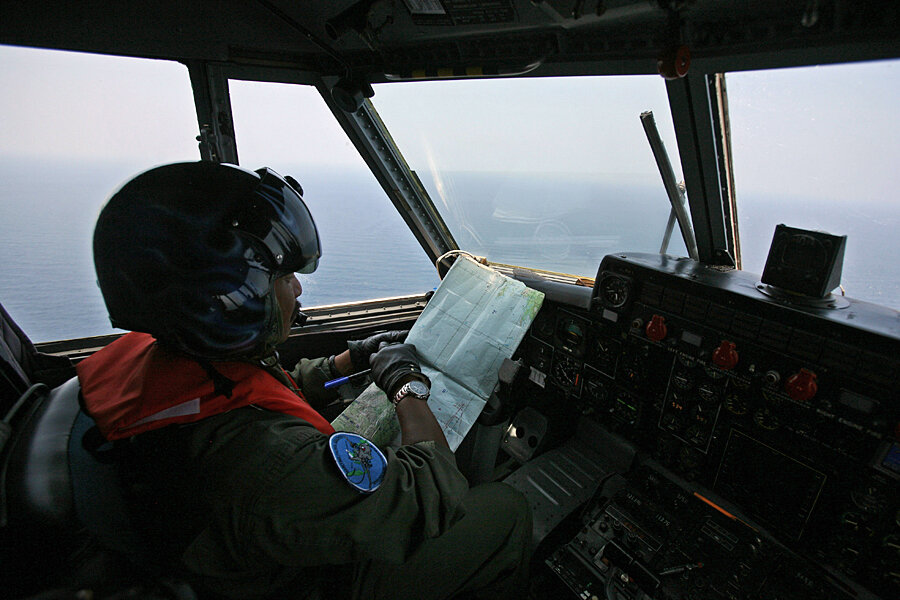Missing Malaysia Airlines plane: What's being done to find the aircraft
Loading...
AiFrom deploying warships and submarines to shifting the orbit of satellites, 10 countries are assisting in the search for the missing Malaysia Airlines plane that disappeared over the South China Sea on Saturday.
At least 45 ships and 22 aircraft are searching for the aircraft, The Wall Street Journal reports, though their efforts have so far turned up empty. Reports of an oil slick and objects that looked like an airplane door or a passenger life jacket have been determined to be unrelated to the plane, according to Reuters.
Finding evidence of a downed airline can be time consuming: It was two years before the black boxes that hold flight information were rescued from the downed Air France plane that crashed over the Atlantic Ocean in 2009. Debris from that crash, however, was found the day following its disappearance, the BBC reports.
Here’s what’s known so far about the search and rescue mission for Malaysia Airlines flight MH370:
What countries are involved?
Malaysia is leading the effort. Its Department of Civil Aviation (DCA) and transport ministry are the coordinators for the search mission, according to a statement from Malaysia Airlines. The DCA confirmed that search and rescue forces from Australia, China, Thailand, Indonesia, Singapore, Vietnam, the Philippines, New Zealand, and the United States are providing assistance.
What resources are on hand?
Malaysia has the largest amount of resources on site with 14 Navy ships, 13 Coast Guard vessels, and 16 aircraft, according to The Wall Street Journal. Forces other countries are providing, according to the BBC, range from marines to submarines and frigates:
Vietnam: Eight ships and seven aircraft
Singapore: Two warships, a submarine support and rescue ship, a Sikorsky naval helicopter, and a C-130 aircraft
Australia: Two P-3C aircraft and two Royal Australian Air Force maritime surveillance aircraft
Thailand: Super Lynx Navy helicopters and a patrol ship
The Philippines: A Fokker F-27 plane, an Islander plane, and two patrol ships
Indonesia: Four rapid patrol vessels, a maritime surveillance plane
China: Nine warships, including a frigate, a landing craft, a destroyer, an amphibious landing ship, and a 50-person marine corps
US: Two destroyers: The USS Pinckney and USS Kidd, which had been training in the South China Sea. Their MH60 Seahawk helicopters, which have been flying at night over the Gulf of Thailand, have infra-red cameras and can fly for more than 10 hours at a time and cover 245 nautical miles. Advisers from the National Transportation Security Board, Boeing, and the Federal Aviation Administration flew to Kuala Lumpur Saturday to help.
How big is the area being searched?
Part of the challenge is the uncertainty over what direction the aircraft was traveling. Radar indications that it may have changed direction right before contact was lost opens the possibility to a far greater sea search.
Azharuddin Abdul Rahman, the head of Malaysia’s Civil Aviation Authority, told reporters today that the search area would be doubled to a 100-nautical-mile radius tomorrow. Rescuers are looking for debris and the emergency locator transmitter, which is supposed to act as a location beacon. No signals have been picked up so far.
Mr. Rahman said ships are traveling to investigate reports of debris that was found south of Hong Kong, reports CNN. Investigators won't be able to comment on that lead until tomorrow at the earliest, he said.
Search efforts have operated so far in the Gulf of Thailand, and in waters to the east of Malaysia and Vietnam in the South China Sea. “The focus has now shifted to the Andaman Sea, near Thailand’s border, after radar data indicate the plane may have turned around to head back to Kuala Lumpur,” reports CNN.
How is China responding?
Two-thirds of the 239 passengers aboard the flight were Chinese citizens. Patience is running thin among many family members who are huddled in a hotel in Beijing to await news. Some family members reportedly threw water bottles at officials from Malaysia Airlines out of frustration with a lack of information.
Chinese officials are also downplaying fears of terrorism sprouting on social media, according to The Christian Science Monitor. The disappearance of the plane comes shortly after a knife attack in Kunming China shook the nation. Chinese officials attributed that attack to Uighur separatists, and several online commentators raised fears that Uighur separatists were also involved in the plane’s disappearance. Neither Chinese or Malaysian authorities have found evidence of terrorism so far, although they are not ruling it out yet.
Chinese Foreign Minister Qin Gang stepped up the pressure on Malaysian authorities today, saying, “We… have a responsibility to demand and urge the Malaysian side to sep up [its] search efforts, start an investigation as soon as possible, and provide relevant information to China correctly and in a timely manner,” he said.
China today shifted the position of up to 10 satellites to help search for the plane. The satellites will be used for high-resolution photographs and weather monitoring, Xinhua, the state-run news agency, reported.
Zhu Feng, a visiting fellow at the Brookings Institution in Washington and international security expert at Peking University, told The Wall Street Journal that the cooperation between countries that are also embroiled in territorial disputes is “a good example of regional cooperation on a multinational rescue operation" that “could be a good model for the future."
On the other hand, "There's an overwhelming humanitarian need involved in finding this jet, and militaries regularly train to handle such missions collaboratively," Carl Thayer, a political scientist and emeritus professor at the Australian Defense Force Academy told the Journal. “At the end of this mission, the strategic situation would simply go back to where it was before.”








